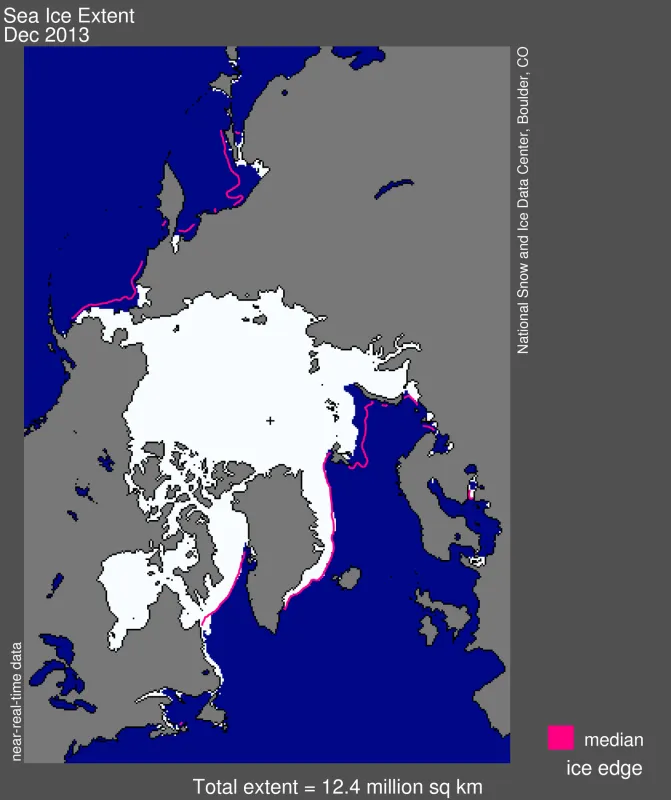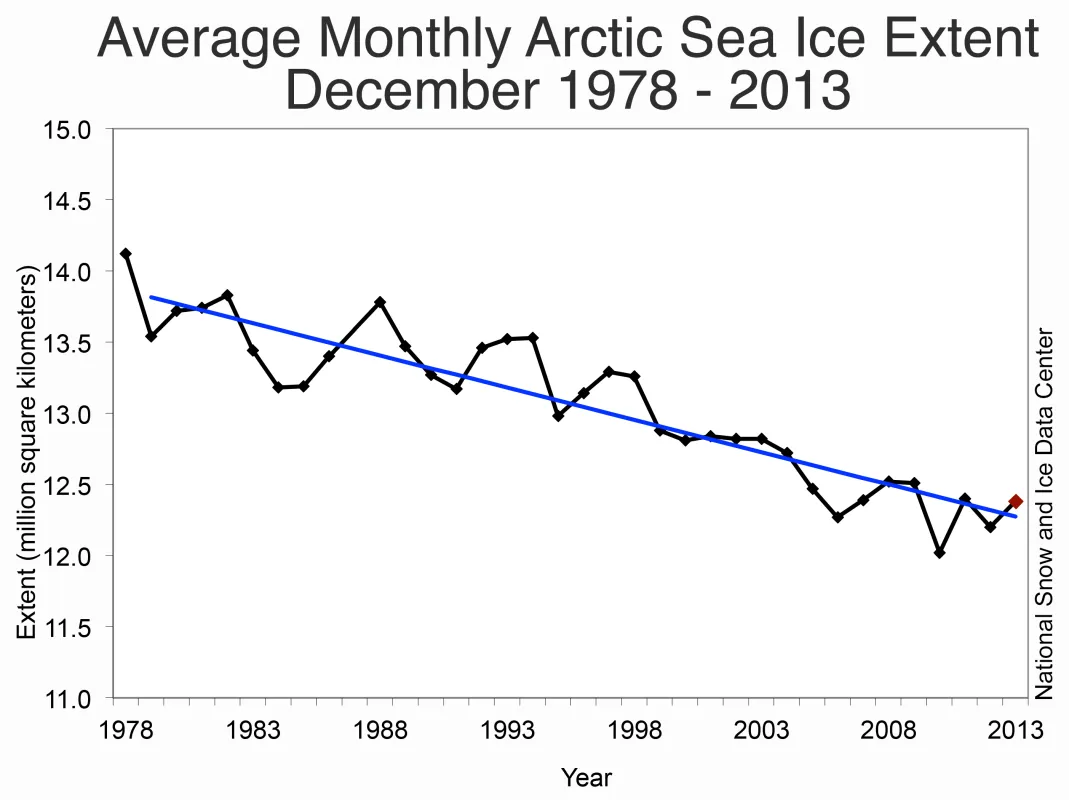Daily sea ice growth rates were variable during December. By the end of the month, ice extent remained below average in most of the far north. In Antarctica, ice extent remained above average and access to the continent by ship has been more difficult than normal.
Overview of conditions
Arctic sea ice extent for December was 12.38 million square kilometers (4.78 million square miles). This is 700,000 square kilometers or 270,300 square miles below the 1981 to 2010 average, making it the 4th lowest December extent in the 36-year satellite data record. Arctic sea ice expanded in December by 1.85 million square kilometers (714,000 square miles), slightly less than average, with some periods of very slow growth and even retreat as storms briefly pushed the sea ice edge northward.
Monthly average ice extent was less than the 1981 to 2010 average in both the far northeast Atlantic (Barents Sea) and along the entire northwest Pacific coast (Bering Sea and Sea of Okhotsk). Near-average ice extent was the rule in the Greenland Sea and Baffin Bay.
Conditions in context
Ice grew at rates slower than average through most of December, at 59,500 square kilometers per day (23,000 square miles per day) compared to the 1981 to 2010 average of 62,400 square kilometers per day (24,100 square miles per day). At the end of the month the extent was 750,000 square kilometers (289,600 square miles) below the 1981 to 2010 average and nearly identical to the extent at the end of 2012.
Similar to November, the early part of December was dominated by a positive Arctic Oscillation pattern, but this shifted to near-neutral conditions by the end of the month. The Icelandic low, covering much of the northern North Atlantic Ocean, was stronger than average, and pressures were higher than average over the Bering Sea and Alaska. Air temperatures at the 925 hPa level (about 3,000 feet above the surface) were above average for the month over most of the Arctic Ocean; unusual warmth was most notable over far eastern Siberia (6 degrees Celsius or 11 degrees Fahrenheit above average). Over the central Arctic Ocean, temperatures at the 925 hPa level were 2 to 5 degrees Celsius or 4 to 9 degrees Fahrenheit above average. By sharp contrast, relatively cool conditions prevailed over northern North America. Temperatures in areas such as the Yukon Territory were 6 degrees Celsius (10 degrees Fahrenheit) or more below average.
December 2013 compared to previous years
The linear trend in ice extent for December (1978 through 2013) is now −3.5% per decade, or −46,500 square kilometers per year (−18,000 square miles per year). The lowest December extent was recorded in 2010 (12.02 million square kilometers or 4.64 million square miles). The spatial pattern of ice extent in December 2013 was similar overall to what was seen in 2010, except that 2010 had much less ice cover in Hudson Bay and Baffin Bay.
2013 in review
While the most notable aspect of 2013 was the much higher September ice extent relative to the record low for 2012, extent in 2013 was nevertheless low overall. The maximum extent for 2013 of 15.13 million square kilometers (5.84 million square miles), recorded on 15 March was the sixth lowest over the period of satellite observations. The minimum of 5.10 million square kilometers (1.97 million square miles), recorded on 15 September, was also the sixth lowest.
Continuing a recent pattern, ice extent remained below average over the northern North Atlantic throughout the year. Sea ice retreat began unusually early in the northern Barents and Kara seas. By comparison, sea ice retreated from the Alaskan coast later than in recent years. This occurred despite unusually active late winter fracturing of the ice pack in the region. The fraction of the Arctic sea ice cover comprised of old ice continued to decline.
Summer weather patterns during 2013 were very different from those seen in 2007 to 2012. Overall it was considerably cooler. There was little evidence of the summer dipole pattern seen in recent years. Relatively cool conditions also characterized the Greenland Ice Sheet, and surface melt was much less extensive than for 2012. The year 2013 reminds us that natural climate variability is very strong in the Arctic.
In Antarctica, sea ice extent has been well above average, setting record extents for both the summer minimum and winter maximum. For a long period over the winter and spring months, ice extent was at a record for the modern satellite era. While remarkable, it is important to note that trends in Antarctic sea ice extent remain small (1 to 4%) and are statistically significant relative to inter-annual variation only for the late autumn, winter, and early spring months. Early satellite records (the Nimbus satellite series in 1964, 1966, and 1969) provide further evidence that Antarctic sea ice extent is highly variable; the three years covered by Nimbus show September extents that were both higher and lower than seen in the modern continuous, calibrated satellite record.
So you want to be like Mawson?
Heavy Antarctic sea ice conditions along the Wilkes Land Coast near France’s Dumont D’Urville Station and persistent onshore to easterly winds have trapped a Russian ice-hardened vessel conducting a mixed science and tourism cruise. The cruise by the Akademik Shokalskiy was attempting to re-measure some of the climate, ice, and ocean conditions made by the Aurora , Sir David Mawson’s research vessel on his 1911 to 1913 expedition to the region. The region is often swept clear of ice by this time in the summer season by strong katabatic offshore winds; Cape Denison and Commonwealth Bay (near to the stuck ship’s location) are recognized as some of the windiest places on Earth. However, December was marked by long periods of northeasterly airflow, pushing the sea ice against the coast, and piling up the thinner flows into a nearly impenetrable mass.
The ship’s entrapment, with limited supplies for the larger science and expedition group, led to a complex multi-ship rescue executed in early January. However, several of the rescue icebreakers are having trouble with the ice conditions. As this summary is written, the U.S. Coast Guard icebreaker Polar Star is planning an attempt to help free the new Chinese research icebreaker Snow Dragon. The Polar Star is among the most powerful icebreakers ever built.


